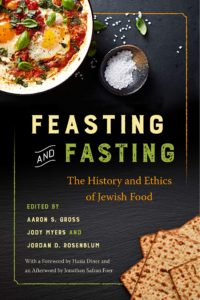Weekend reading: History and Ethics of Jewish Food
Aaron S. Gross, Jody Myers, and Jordan D. Rosenblum. Feasting and Fasting: The History and Ethics of Jewish Food. New York University Press, 2020.

This book comes with heavy-duty endorsements: a Foreword by Hasia Diner, and an Afterword by Jonathan Safran Foer.
I was interested to read it and did a blurb for it.
Feasting and Fasting is a fascinating account of the history of Jewish food, within and outside of dietary laws. The authors engage in Talmudic debates about how specific foods and diets as a whole do or do not define Jewish identity. Crisco is for Jews? Peanut oil caused such debates? Who knew. This book is a great read.
What to quote? So many choices. Here’s a snippet from Jordan Rosenblum’s chapter on Jews and garlic:
After the Exodus from Egypt, when the Israelites wandered in the desert, they grew tired of eating only manna. Comparing the varied diet that they ate as slaves in Egypt to the unvaried diet that they now enjoyed as free women and men, a few troublemakers complained: “The riffraff in their midst felt a gluttonous craving; and then the Israelites wept and said, “If only we had meat to eat! We remember the fish that we used to eat free in Egypt, the cucumbers, the melons, the leeks, the onions, and the garlic.”
This, as it turns out, is the only mention of garlic in the Hebrew Bible. In this chapter,
we shall briefly explore the historical association between Jews and garlic that develops over the next three millennia. In doing so, we shall see how garlic eventually functions both internally (by Jews) and externally (by non-Jews) as a symbol that represents Self and Other—or, in the terminology favored in anthropology and food studies, how garlic operates as a metanym for Jews.

